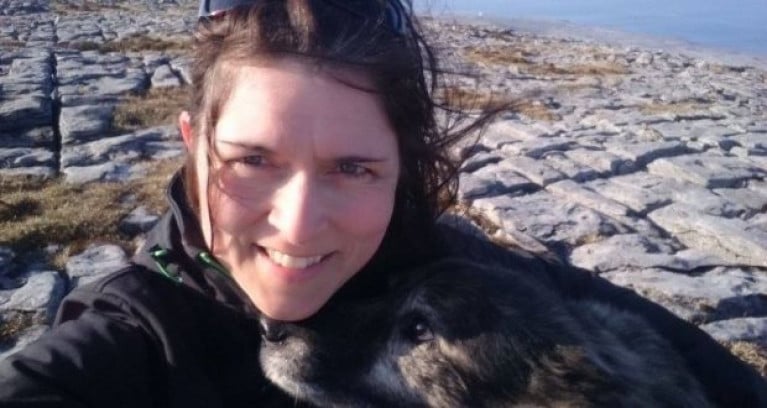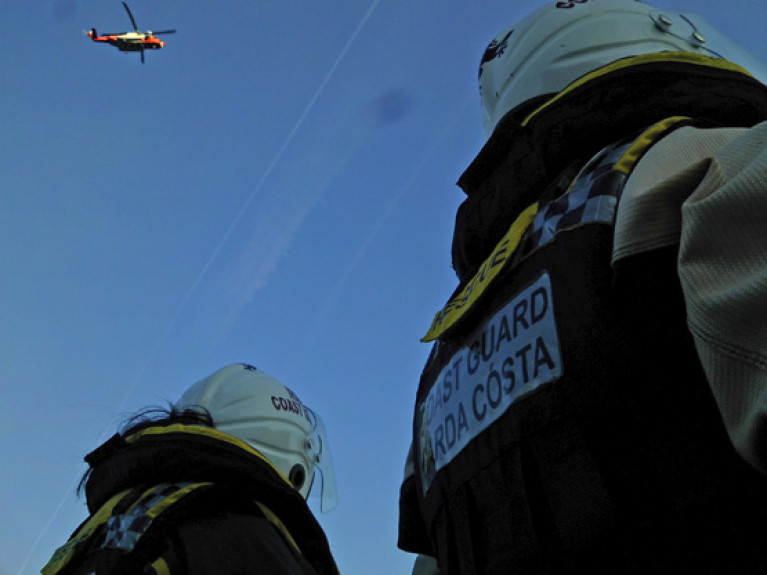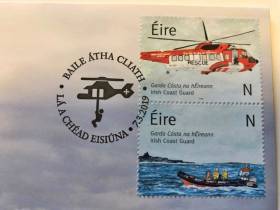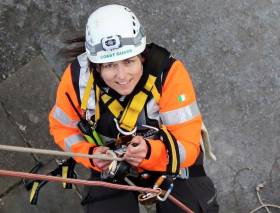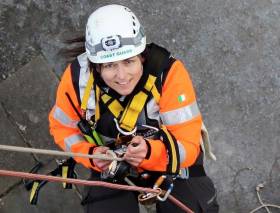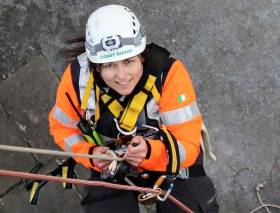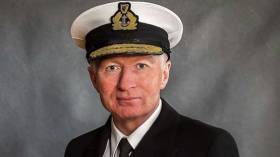Displaying items by tag: Caitriona Lucas
2022 Caitriona Lucas Challenge - Bernard Lucas and Colleagues set off for Mount Kilimanjaro
Clare Coast Guard volunteer Bernard Lucas left Ireland at the weekend for Tanzania on the 2022 Caitriona Lucas Challenge to climb Mount Kilimanjaro.
Dedicated to the memory of his late wife, Caitriona – the first Irish Coast Guard volunteer to die on active service – Lucas and team mates Cormac Coyne of Inis Oírr and Eoin Keane from Kilfenora aim to raise funds for the Burren Chernobyl Project.
The 5,895 meters (19,341 feet) peak is the highest mountain in Africa and the tallest freestanding mountain in the world.
Acclimatising to altitude will be one of the team’s greatest challenges, given the very individual impact on physiology of lower oxygen levels.
 Bernard Lucas and colleagues Cormac Coyne, Micheál Healy and Eoin Keane on the summit of Kerry's Mount Brandon during final training for this year's Caitriona Lucas Challenge
Bernard Lucas and colleagues Cormac Coyne, Micheál Healy and Eoin Keane on the summit of Kerry's Mount Brandon during final training for this year's Caitriona Lucas Challenge
Their final training run together involved participating in the Tom Crean Endurance Walk in Kerry last weekend.
Covid-19 had forced a pause to the annual challenge, which involved climbing 26 mountains across 32 counties in just 10 days in 2018 for charity.
 Cormac Coyne, Pauliina Kauppila and Bernard Lucas on the Tom Crean Endurance Walk Photo: Cormac Coyne
Cormac Coyne, Pauliina Kauppila and Bernard Lucas on the Tom Crean Endurance Walk Photo: Cormac Coyne
The following year, 2019, Lucas and five colleagues – Cormac Coyne, Michael Healy, Pauliina Kauppila, Eoin Keane and Deirdre Linnane – travelled to Greenland for the Arctic Circle trail. An estimated average of 300 people annually tackle the 100-mile wilderness walk.
In an interview with Afloat’s Wavelengths podcast earlier this month, Lucas spoke about the Kilimanjaro climb preparations.
He also spoke about the situation with Doolin Coast Guard where he and nine other volunteers were dismissed, and about many unanswered questions relating to his wife’s death off the Clare coast on September 12th, 2016.
Several weeks ago, international maritime lawyer Michael Kingston questioned the delay in holding an inquest into the highly experienced Irish Coast Guard coxswain’s death.
 Bernard Lucas on the Tom Crean Endurance Walk in Kerry (photo Cormac Coyne)
Bernard Lucas on the Tom Crean Endurance Walk in Kerry (photo Cormac Coyne)
“It is shocking that almost six years after Ms Lucas’s death, no inquest has as yet been heard,” Mr Kingston told The Sunday Independent, pointing out that such a hearing would “properly investigate” what happened.
Mother-of-two Ms Lucas (41), an advanced coxswain with Doolin Coast Guard in Co Clare, had offered to help out the neighbouring Coast Guard unit from Kilkee in the search for a missing man.
She died after the Kilkee rigid inflatable boat (RIB) capsized in a shallow surf zone. Two other crew members on board the RIB, who were also thrown into the sea, survived.
Her husband and a number of Kilkee Coast Guard volunteers criticised aspects of the Marine Casualty Investigation Board report, which was published in two parts due to the extensive nature of submissions on the draft.
As Ms Lucas was pronounced dead in hospital in Limerick, responsibility for her inquest is with the Limerick coroner’s office.
The newspaper report said that the Limerick coroner’s office did not respond to several requests for comment
You can listen back to Bernard Lucas’s interview here And more details on the Caitriona Lucas Challenge are here
Bernard Lucas on Doolin Coast Guard and Climbing Mount Kilimanjaro for the Caitriona Lucas Challenge
On June 25th, Clare coast guard volunteer Bernard Lucas, along with Cormac Coyne of Inis Oir and Eoin Keane from Kilfenora will set out to climb 5,895 metres (19,341 feet) to the summit of Mount Kilimanjaro the highest mountain in Africa and the tallest freestanding mountain in the world.
The trio are making the ascent for the Caitriona Lucas Challenge, with funds going to the Burren Chernobyl Project. The challenge is named after Bernard’s late wife, Caitriona, who lost her life off the Clare coast on September 12th, 2016 - the first Irish Coast Guard volunteer to die while on a call-out.
Bernard spoke to Wavelengths this week about the climb, about the situation with Doolin Coast Guard where he and nine other volunteers were dismissed, and about many unanswered questions relating to Caitriona’s death.
Listen to Wavelengths below
Asked to respond to Bernard’s appeal for Minister of State for Transport Hildegarde Naughton to meet the Doolin Coast Guard unit, her department said that the Coast Guard is “currently fully engaged in the process of rebuilding the Doolin Unit, guided by the recommendations outlined in Kieran Mulvey’s report, issued on December 10th 2021.
“We can confirm that the selection of volunteers to provide service to the re-constituted unit on an interim basis as per the report recommendations was completed and those selected were informed,” it said.
 Cormac Coyne (left) and Bernard Lucas, in training for the Caitriona Lucas Challenge to Mount Kilimanjaro in June 2022
Cormac Coyne (left) and Bernard Lucas, in training for the Caitriona Lucas Challenge to Mount Kilimanjaro in June 2022
“We can now confirm that management within the Coast Guard has commenced the process of recruitment to the Doolin Unit on a permanent basis. We can also confirm they have recently been in contact with all former volunteers in relation to this recruitment process,” the department said.
“The minister and the Coast Guard are fully engaged in this process and are very committed to ensuring Doolin Coast Guard Unit’s continued growth and renewal,” it continued.
“The minister meets with and engages with Coast Guard Unit volunteers on a regular basis and will also meet with Doolin Coast Guard Unit volunteers as part of this continuous engagement,” it said.
Details of the Caitriona Lucas Challenge to Mount Kilimanjaro are here
 Caitriona and Bernard Lucas, Newfoundland, in October 2014
Caitriona and Bernard Lucas, Newfoundland, in October 2014
Bernard Lucas Calls for Reinvestigation into Death of His Wife & Irish Coast Guard Volunteer Caitriona Lucas
Irish Coast Guard volunteer Bernard Lucas has called for a re-investigation into the cause of his wife Caitriona’s death off the Clare coast in 2016.
In an interview with today’s Sunday Independent, Mr Lucas says he finds as “shocking” the criticisms of the Marine Casualty Investigation Board (MCIB) in a report commissioned by maritime lawyer Michael Kingston.
The report by Capt Neil Forde of Marine Hazard Ltd said the MCIB was “not fit for purpose”.
It was submitted by Mr Michael Kingston to several Oireachtas committees, including the Transport and Communications Network committee which sat on Friday last.
Ms Lucas (41), a librarian, mother of two, and advanced coxswain, had offered to help out the neighbouring Irish Coast Guard Kilkee unit in a search for a missing man on September 12th, 2016.
She hadn’t expected to go to sea, but the unit was short a crew member. She died after the Kilkee rigid inflatable boat (Rib) capsized in a shallow surf zone. Two other crew members survived.
Last summer, the Director of Public Prosecutions (DPP) decided that no criminal charges should be brought in relation to the incident after a report was forwarded to it by the Health and Safety Authority (HSA).
The unpublished HSA report was one of two separate investigations. The second report by the Marine Casualty Investigation Board (MCIB) proved so contentious that it had to be published in two parts, and the responses to the draft were longer than the report itself.
In a robust response, the Irish Coast Guard described the MCIB report as “flawed” and “misleading”, and argued that it was a “significant leap” to draw wider conclusions about safety standards based on one “tragic accident”.
In his submission to the draft report, Bernard Lucas queried why the investigation did not address failure to find personal locator beacons and other equipment issues, including the loss of helmets by three crew and the failure of lifejackets to inflate.
A postmortem identified a trauma to the side of Ms Lucas’s head at a point where it should have been protected by her helmet.
Last summer, the MCIB’s authority was questioned in a European Court of Justice judgment which found it is not independent as its board included the Department of Transport secretary-general, or his or her deputy, and the Marine Survey Office (MSO) chief surveyor. These two post holders have recently stood down.
The report commissioned by Mr Kingston claims the MCIB failed to investigate certain incidents which it has a statutory duty to inquire about, it questions its resources and independence.
It also says the MCIB inquiry into Caitriona Lucas’s death is “riddled with inaccuracies” – starting with the wrong location for the incident.
These inaccuracies were not corrected, even when highlighted in responses to the draft report, because MCIB investigators” simply have not had the resources required to do the job properly”, Mr Kingston told the Oireachtas Transport and Communications Networks committee hearing on Friday.
Capt Forde’s analysis also questions why the MCIB did not also investigate a previous incident which occurred in similar circumstances to that of Ms Lucas’s death, where an Irish Coast Guard Dingle unit RIB capsized in a surf zone off Inch, Co Kerry in August 2014.
The MCIB said in response that it does not comment on published reports issued on the conclusion of investigations, and said it was not the purpose of an investigation to attribute blame or fault – but to avoid other casualties occurring.
“Any person may report a marine accident to the MCIB directly and details are on the website,”it said in response to questions about its failure to follow up on the Dingle incident.
“All on-going investigations are noted on the website and members of the public may submit evidence about an investigation at any time should they so wish,” it said.
“The board may also re open investigations where it receives evidence to warrant that course of action,” it said, but it was “not in receipt of any requests to re-open any investigation, nor is it in receipt of any objections by any interested parties to the recommendations it has made”.
“The members of the MCIB recognise that some investigations arise from very tragic circumstances and that any investigation may cause added distress,” it said.
Read more on the Sunday Independent here
New TG4 Documentary Reaches Into Heart & Soul Of Irish Coast Guard
Following January’s film on Ireland’s offshore fishing industry, the latest episode of TG4 documentary series Tabú reaches into the heart and soul of the Irish Coast Guard — as told by the coastguard members in their own words.
In the aftermath of the loss of Rescue 116 and volunteer Caitríona Lucas, An Garda Cósta - Ár n-Insint Féin, which screens this coming Wednesday 4 March, explores how they continue to serve in spite of the tragedies.
Focusing on operations after the biggest tragedy that has happened to any Blue Light service in Ireland, the hour-long film reveals the anguish of the search, along with the coping mechanisms of “the coastguard family”.
And according to the producers, the documentary also reveals the dangers of the job and how they stay on the right side of risk.
Produced and directed by Darina Clancy for Midas Productions, Tabú: An Garda Cósta - Ár n-Insint Féin broadcasts Wednesday 4 March at 9.30pm on TG4.
#Coastguard - Two new postage stamps in tribute to the Irish Coast Guard are based on a painting by a volunteer who died in service, as the Sunday Independent reports.
The painting by Caitríona Lucas, who died during a rescue operation off Kilkee in September 2016, has been adapted into a tribute to both her and the crew of the coastguard helicopter Rescue 116 who were lost in March 2017.
Two stamps show separately a rendering of the Sikorsky S-92 helicopter, and an Irish Coast Guard rescue boat similar to what Caitríona had crewed.
The commemorative stamps were launched at the GPO last week by members of the coastguard and Caitríona’s widower Bernard.
In a joint statement, coastguard units in Skerries, Dun Laighaire and Greystones said their thoughts are with the families of Caitríona, Capt Dara Fitzpatrick, Capt Mark Duffy, winch operator Paul Ormsby and winchman Ciaran Smith.
“This gesture by An Post is heartwarming to us all,” they added.
#Coastguard - There was no evidence of effective management at Kilkee’s coastguard station when volunteer Caitríona Lucas died during a rescue operation almost two years ago, according to a draft report into the incident.
The Irish Times has details of the draft report from the Marine Casualty Investigation Board (MCIB), which adds that the RIB on which Lucas was travelling before it capsized on 12 September 2016 was being used outside of the Irish Coast Guard’s own operational limits.
Parallels were also drawn to a similar incident two years prior involving a coastguard RIB in a “surf zone” near Dingle, which prompted a series of recommendation that were not “fully implemented” by the Irish Coast Guard, according to the MCIB.
The Irish Times has much more on the story, while Lorna Siggins also writes on how Lucas’ death occurred amid a tumultuous time for the Co Clare coastguard unit.
New Stamp Collection To Remember Lost Search & Rescue Personnel
#Coastguard - Next year’s commemorative stamp programme from An Post will feature a tribute to the four coastguard crew lost in the Rescue 116 tragedy one year ago.
RTÉ News reports that Caitriona Lucas, the coastguard volunteer who died during a rescue mission in September 2016, will be included as part of a series paying tribute to the work of the Irish Coast Guard.
Among other stamps due in 2019 will be one to mark 100 years since the first non-stop transatlantic flight from Newfoundland to Galway by British aviators Alcock and Brown.
Protest In Kilkee Over Reduced Coastal Rescue Service
#Coastguard - Irish Coast Guard management faced a protest march at the weekend over Kilkee’s lack of a full rescue service — and one restricted further since the death last year of coastguard volunteer Caitriona Lucas, as The Irish Times reports.
Locals were demonstrating for the second time this month over what former mayor Manuel di Lucia said was an issue that dated back to when the Irish Coast Guard took over the Co Clare’s town’s community lifeboat in 2013.
The paper’s sources allege inconsistent management and a lack of training and qualified crew compounded the situation that led to the death of Lucas, when the RIB she was travelling in capsized during a search operation. Her bravery at sea was recognised with a posthumous award of the State's highest honour earlier this month.
The Irish Times has much more on the protest, which came on the same weekend that Lucas and the lost crew of Rescue 116 were remembered at a memorial service for those who died in the Cleggan Bay Disaster in 1927.
Late Coastguard Volunteer Caitriona Lucas Awarded Irish State’s Highest Award For Bravery
#Coastguard - The late Irish Coast Guard volunteer Caitriona Lucas has been recognised in this year’s National Bravery Awards.
The Posthumous Gold Medal and Certificate of Bravery were presented to Lucas’ family at Farmleigh House yesterday (Friday 20 October) a year after she died during a search operation in Kilkee when her RIB capsized.
“Catriona’s courage and selfless action on that day says everything about her — her strength of character and spirit and willingness to help others,” said Ceann Comhairle Seán Ó’ Fearghaíl, who presented the awards to 15 recipients.
“It is also a reminder of how committed and brave members of our emergency services put their lives on the line on a daily basis to help and protect their communities.
“Caitriona’s family accepted a Gold Medal for Bravery in recognition of her courage, which is the highest award possible.”
Others recognised at the ceremony yesterday include Darren McMahon, who was awarded a Certificate of Bravery for his attempt to rescue his brother from a kayak trapped in a weir gate in Ennis.
Bronze Medals and Certificates of Bravery also went to scouts Sean Baitson, Kyle Corrigan, Cory Ridge Grenelle and Philip Byrne for their attempts to rescue 14-year-old Aoife Winterlich, who died after being swept into the sea during an outing at Hook Head Lighthouse in December 2015.
Byrne in particular was noted for his efforts to keep Winterlich afloat in the rough waters before help arrived.
Coastguard Chief Speaks Of Sorrow Over Lost Colleagues Ahead Of Return From EU Secondment
#Coastguard - Irish Coast Guard director Chris Reynolds has paid tribute to the lives lost in the Rescue 116 and Kilkee tragedies ahead of his return from secondment in Somalia.
“The Coast Guard has lost five colleagues to accident and one, Daithi O’Cearbhallain, to cancer. I’ve lost six good friends,” said Reynolds, according to The Irish Sun.
“Not being at home and with my team in the Coast Guard has been very, very difficult,” he added.
“My first intention on my return in October is to visit our volunteer teams, co-ordination centres and helicopter bases to listen and understand how we will move forward.”
Reynolds was seconded to Somalia in July 2016 as part of an EU maritime security mission in the Horn of Africa.
Two months after his departure, coastguard volunteer Caitriona Lucas died during a search operation in Kilkee when her RIB capsized.
Six months later, Rescue 116 crashed at Black Rock in Co Mayo, claiming the lives of its four crew. Capt Dara Fitzpatrick and Capt Mark Duffy were recovered, but the bodies of winch men Paul Ormsby and Ciaran Smith were not found.


























